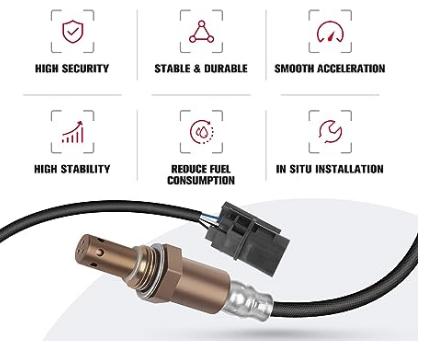Your cart is currently empty!
What are the symptoms of poor oxygen sensor? What are the symptoms of poor oxygen sensor?
The oxygen sensor in your vehicle plays a pivotal role in monitoring the air-fuel mixture, ensuring optimal combustion, and reducing harmful emissions. A poor oxygen sensor can lead to a range of performance issues and increased emissions. In this article, we will explore the symptoms of a poor oxygen sensor and how to identify these signs, helping you maintain your vehicle's efficiency and environmental responsibility.

What are the symptoms of poor oxygen sensor?
A poor oxygen sensor can manifest in various ways, and recognizing these symptoms is crucial for timely diagnosis and repair:
Check Engine Light (CEL): One of the most common signs is the illumination of the check engine light on your dashboard. This light often indicates an issue with the oxygen sensor or other related components.
Decreased Fuel Efficiency: A poor oxygen sensor can lead to incorrect readings of the air-fuel mixture, resulting in reduced fuel efficiency and increased fuel consumption.
Rough Idling: An irregular or rough idling engine can be a consequence of an imbalanced air-fuel mixture caused by a poor oxygen sensor.
Increased Emissions: A poor oxygen sensor can lead to higher emissions of pollutants like carbon monoxide (CO) and nitrogen oxides (NOx), which can result in environmental non-compliance and may cause your vehicle to fail emissions tests.
How to inquire the symptoms of poor oxygen sensor?
Identifying the symptoms of a poor oxygen sensor requires a combination of observation and diagnostic tools. Here's how to inquire about these symptoms:
Check Engine Light (CEL): If your check engine light illuminates, it's essential to connect an OBD-II scanner to your vehicle's onboard diagnostics port. This will provide specific error codes related to the oxygen sensor or other potential issues.
Fuel Efficiency Monitoring: Keep an eye on your vehicle's fuel efficiency. If you notice a significant decrease in miles per gallon (MPG), it could be indicative of a problem with the oxygen sensor.
Listen for Engine Performance: Pay attention to your engine's performance. If you experience rough idling, stalling, or hesitation during acceleration, it may be related to an poor oxygen sensor.
Emissions Testing: If you suspect a problem with your oxygen sensor, consider scheduling an emissions test. Elevated emissions levels are a strong indicator of sensor malfunction.
Visual Inspection: Sometimes, oxygen sensors can become contaminated or damaged. A visual inspection may reveal signs of physical damage or fouling.
Conclusion:
A poor oxygen sensor can significantly impact your vehicle's performance, fuel efficiency, and environmental impact. Recognizing the symptoms of a malfunctioning sensor is essential for maintaining your vehicle's efficiency and adhering to emission standards. If you suspect your oxygen sensor is in poor condition, it's advisable to consult a qualified mechanic for a thorough diagnosis and replacement if necessary. By addressing these issues promptly, you can ensure your vehicle runs smoothly and responsibly.






Leave a Reply